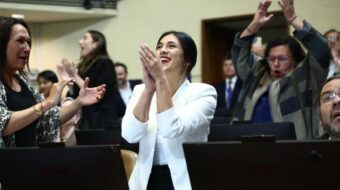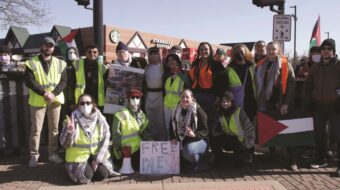Twenty-five years ago on October 11 1987, someone killed Jaime Pardo Leal, presidential candidate of the Patriotic Union electoral coalition formed by the Revolutionary Armed Forces of Colombia (FARC) and Colombian communists. In all, 4,000 other UP activists were murdered. Also on October 11, the Colombian government announced that current members of FARC and the Communist Party, always endangered, would be protected.
There was a catch, however. Protection must await a successful outcome of peace negotiations which were set to begin in Norway on October 17 between the Colombian government and the FARC. However, bad weather has now delayed their start.
The negotiations may well give rise to other inconsistencies, unless, of course, they break down beforehand. That’s because both sets of negotiators have limited bargaining powers as a result of old divisions on both sides.
The government, for instance, must cope with an old-guard of big landowners, agribusiness interests, narco-traffickers, and military chieftains. The leader of these entrenched interests is ex-President Alvaro Uribe, a strident critic of negotiations. They’re used to free rein in rural Colombia where civilian government authority and services are in short supply.
Now, conservative President Juan Manuel Santos would end authoritarian rule and military repression in the countryside, also the “gigantic scandals,” corruption, drug money in politics, and police violence. Prominent human rights leader and Congressional Representative Ivan Cepeda says the Santos government is looking to restore Colombia’s international credibility and profit-making potential by reassuring foreign investors that criminal behavior won’t be tolerated. Toward that end, the government would abandon civil war.
Investors are indeed useful: The Colombian economy grew at an annual 4.9 percent rate from April through June 2012 thanks mainly to an 18.4 percent expansion in construction and 8.6 percent growth in the mining and energy sectors, the latter fueled by 46 percent direct foreign investment. Nevertheless, powerbroker heirs to a tradition of rough and ready autonomy may not be convinced.
Nor will FARC negotiators work in isolation. Their cause is peace with social justice for which the FARC requires collaboration from those with broader experience in popular struggle than theirs. From its start, the Marxist insurgency has focused on land use injustices derived from concentrated land ownership originating with Spanish colonists and continuing under large-scale agricultural operators and drug traffickers. Early FARC militants were the so-called “colonos,” small farmers scratching out a living in areas far removed from state authority, or dispossessed.
On the day of its formation, July 20, 1964, the FARC issued its “Agrarian Program” calling “for a fundamentally changed social structure of the Colombian countryside [and] delivering land completely free to small farmers working or wanting to work the land.” Continuing that line in February 2012, FARC Secretariat member Iván Márquez wrote that land “belongs to us, because we were born on it…Our own country has been converted into a treasure coveted by transnational piracy [and] land investment is a strategic pursuit today.”
In 1986 British historian Eric Hobsbawm offered an opinion on the FARC’s revolutionary potential, which may still hold. The recently deceased Hobsbawm, who had visited FARC encampments, seconded the insurgency’s goal of creating a “peasant – labor radical party” to exert pressure on urban liberals. Conditioned by the “wild west” aspects of its environs and by ultimate power being lodged in cities, the FARC was ill prepared to take on independent political leadership within an entire society.
Recent social data are dismal enough to suggest all hands are required. Under Gini coefficient reckonings, Colombia is the third most unequal country in the world. Some 54 percent of Colombians live in poverty with higher rates in rural areas. Half of all Colombians lack “basic necessities,” including 60 percent of indigenous people and 68 percent of Afro Colombians. United Nations figures show that, annually, 20,000 Colombian children under the age of five die of malnutrition and that 12 percent are undernourished.
Thus FARC negotiators rely upon far – removed allies for help in settling crucial issues. A recently staged nationwide “Week of Indignation,” for example, included demonstrations, academic forums, encampments, and cultural events. On October 12, its last day, 300,000 protesters demonstrated throughout the country on behalf of health care, quality education, better housing, bi-lateral ceasefire, and basic structural reforms.
Contradictions, however, persist. Peaceful protest triggered armed repression on the eve of peace negotiations: “illegal arrests of peasants and stigmatization by military commanders were flaring up in time for the October 12 date when city and country people alike march for peace and to reclaim social, economic, and environmental rights for the excluded.” News reports on the October 12 outpouring highlighted multiple arrests and photos of bloodied demonstrators.
Not least among determinants of likely ambiguous outcome markers of any accord is U.S. government maneuvering. Through military and intelligence assistance programs, the United States has been beating up on FARC combatants from before they even formed a revolutionary organization.

MOST POPULAR TODAY

‘Warning! This product supports genocide’: Michigan group aims to educate consumers

“Trail of Tears Walk” commemorates Native Americans’ forced removal

Hold the communism, please: SFMOMA’s Diego Rivera exhibit downplays artist’s radical politics

Ohio: Franklin County treasurer attends Netanyahu meeting, steps up Israel Bond purchases

After months of denial, U.S. admits to running Ukraine biolabs






Comments